EXECUTION VERSION EMPLOYMENT AGREEMENT THIS EMPLOYMENT AGREEMENT and Addendum to Employment Agreement attached hereto (collectively, this “Agreement”), dated as of April 9, 2018, is between Dice Inc., a Delaware corporation (the “Company”), with its...

EXECUTION VERSION EMPLOYMENT AGREEMENT THIS EMPLOYMENT AGREEMENT and Addendum to Employment Agreement attached hereto (collectively, this “Agreement”), dated as of April 9, 2018, is between Dice Inc., a Delaware corporation (the “Company”), with its principal place of business at 0000 Xxxxxx xx xxx Xxxxxxxx, Xxx Xxxx, Xxx Xxxx 00000, Art Zeile an individual, whose address is reflected in the Company’s records (the “Employee”), and, solely for the purposes of Sections 1 and 2(b) of the Addendum, DHI Group, Inc. (“Parent”). In consideration of the Company’s securing the services of the Employee as the Company’s President and Chief Executive Officer, and the Employee’s undertaking employment with the Company in such positions, the Company and the Employee hereby agree to be bound by and comply with the following terms and conditions and agree as follows: Section 1. At-Will Employment. The Employee acknowledges and agrees that his employment status is that of an employee-at-will and that the Employee’s employment may be terminated by the Company or the Employee at any time with or without cause, subject to the terms and conditions in the Addendum to Employment Agreement hereto. The Employee’s start date shall be on or about April 9, 2018 (the date on which the Employee actually commences services, the “Employment Commencement Date”). Section 2. Compensation. In consideration of the services to be rendered hereunder, the Employee shall be paid, and the Company shall pay the Employee, in accordance with the Addendum to Employment Agreement attached hereto. Section 3. Employee Inventions and Ideas. (a) For purposes of this Agreement, “Inventions” shall mean all ideas, potential marketing and sales relationships, inventions, copyrightable expression, research, plans for products or services, marketing plans, computer software (including, without limitation, source code), computer programs, original works of authorship, characters, know-how, trade secrets, information, data, developments, discoveries, improvements, modifications, technology, algorithms and designs, whether or not subject to patent or copyright protection, made, conceived, expressed, developed, or actually or constructively reduced to practice by the Employee solely or jointly with others during the term of the Employee’s employment with the Company, which result from any work which the Employee may do during his employment, or from any information obtained from the Company or any affiliate of the Company in the course of his employment by the Company. (b) All Inventions shall be the exclusive property of the Company, and the Employee acknowledges that all of said Inventions shall be considered as “work made for hire” belonging to the Company. To the extent that any such Inventions, under applicable law, may not be considered work made for hire by the Employee for the Doc#: US1:11947543v3 11573700.4 11573700.6
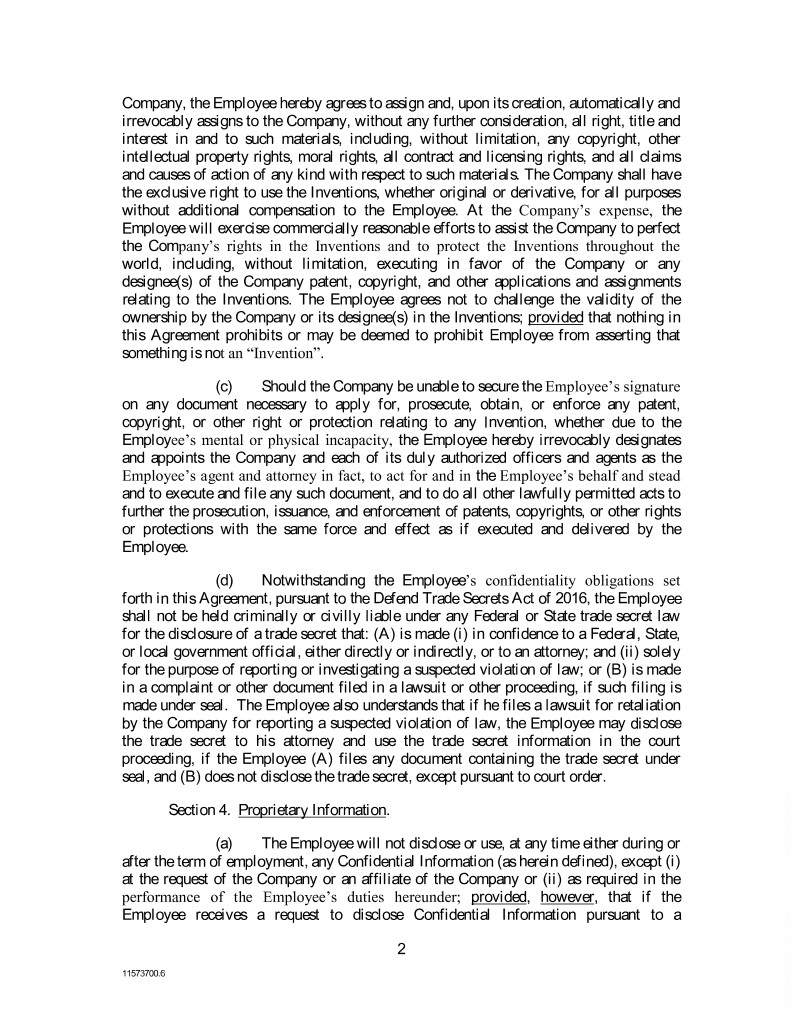
Company, the Employee hereby agrees to assign and, upon its creation, automatically and irrevocably assigns to the Company, without any further consideration, all right, title and interest in and to such materials, including, without limitation, any copyright, other intellectual property rights, moral rights, all contract and licensing rights, and all claims and causes of action of any kind with respect to such materials. The Company shall have the exclusive right to use the Inventions, whether original or derivative, for all purposes without additional compensation to the Employee. At the Company’s expense, the Employee will exercise commercially reasonable efforts to assist the Company to perfect the Company’s rights in the Inventions and to protect the Inventions throughout the world, including, without limitation, executing in favor of the Company or any designee(s) of the Company patent, copyright, and other applications and assignments relating to the Inventions. The Employee agrees not to challenge the validity of the ownership by the Company or its designee(s) in the Inventions; provided that nothing in this Agreement prohibits or may be deemed to prohibit Employee from asserting that something is not an “Invention”. (c) Should the Company be unable to secure the Employee’s signature on any document necessary to apply for, prosecute, obtain, or enforce any patent, copyright, or other right or protection relating to any Invention, whether due to the Employee’s mental or physical incapacity, the Employee hereby irrevocably designates and appoints the Company and each of its duly authorized officers and agents as the Employee’s agent and attorney in fact, to act for and in the Employee’s behalf and stead and to execute and file any such document, and to do all other lawfully permitted acts to further the prosecution, issuance, and enforcement of patents, copyrights, or other rights or protections with the same force and effect as if executed and delivered by the Employee. (d) Notwithstanding the Employee’s confidentiality obligations set forth in this Agreement, pursuant to the Defend Trade Secrets Act of 2016, the Employee shall not be held criminally or civilly liable under any Federal or State trade secret law for the disclosure of a trade secret that: (A) is made (i) in confidence to a Federal, State, or local government official, either directly or indirectly, or to an attorney; and (ii) solely for the purpose of reporting or investigating a suspected violation of law; or (B) is made in a complaint or other document filed in a lawsuit or other proceeding, if such filing is made under seal. The Employee also understands that if he files a lawsuit for retaliation by the Company for reporting a suspected violation of law, the Employee may disclose the trade secret to his attorney and use the trade secret information in the court proceeding, if the Employee (A) files any document containing the trade secret under seal, and (B) does not disclose the trade secret, except pursuant to court order. Section 4. Proprietary Information. (a) The Employee will not disclose or use, at any time either during or after the term of employment, any Confidential Information (as herein defined), except (i) at the request of the Company or an affiliate of the Company or (ii) as required in the performance of the Employee’s duties hereunder; provided, however, that if the Employee receives a request to disclose Confidential Information pursuant to a 2 11573700.6
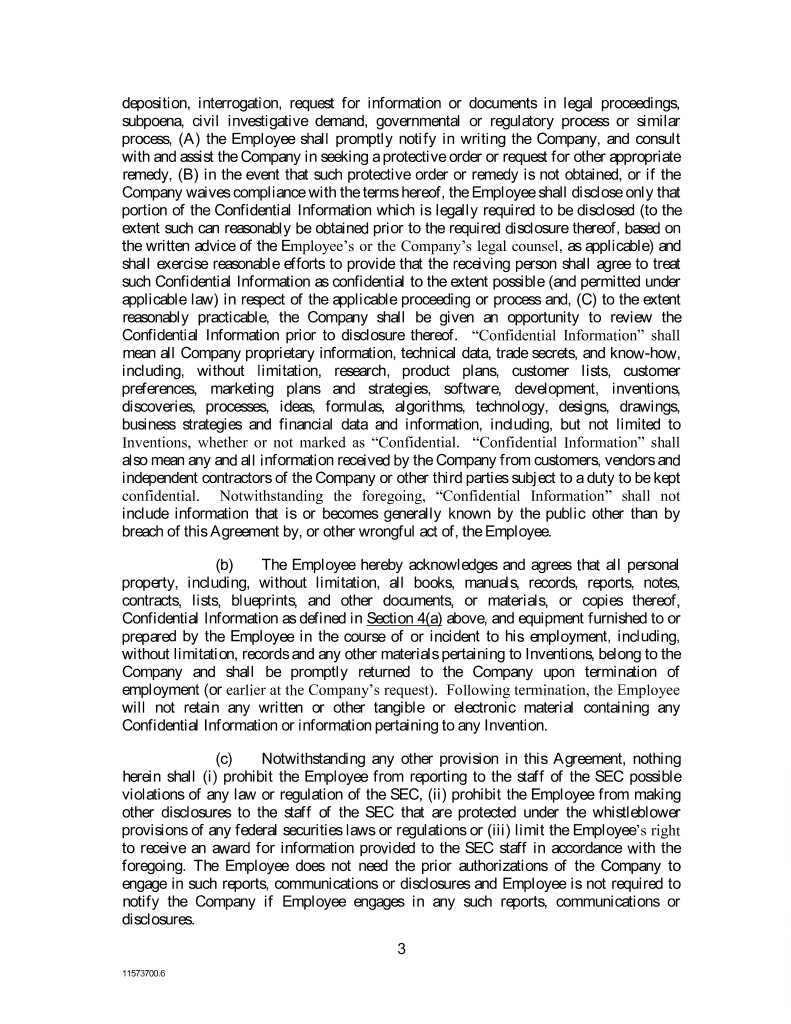
deposition, interrogation, request for information or documents in legal proceedings, subpoena, civil investigative demand, governmental or regulatory process or similar process, (A) the Employee shall promptly notify in writing the Company, and consult with and assist the Company in seeking a protective order or request for other appropriate remedy, (B) in the event that such protective order or remedy is not obtained, or if the Company waives compliance with the terms hereof, the Employee shall disclose only that portion of the Confidential Information which is legally required to be disclosed (to the extent such can reasonably be obtained prior to the required disclosure thereof, based on the written advice of the Employee’s or the Company’s legal counsel, as applicable) and shall exercise reasonable efforts to provide that the receiving person shall agree to treat such Confidential Information as confidential to the extent possible (and permitted under applicable law) in respect of the applicable proceeding or process and, (C) to the extent reasonably practicable, the Company shall be given an opportunity to review the Confidential Information prior to disclosure thereof. “Confidential Information” shall mean all Company proprietary information, technical data, trade secrets, and know-how, including, without limitation, research, product plans, customer lists, customer preferences, marketing plans and strategies, software, development, inventions, discoveries, processes, ideas, formulas, algorithms, technology, designs, drawings, business strategies and financial data and information, including, but not limited to Inventions, whether or not marked as “Confidential. “Confidential Information” shall also mean any and all information received by the Company from customers, vendors and independent contractors of the Company or other third parties subject to a duty to be kept confidential. Notwithstanding the foregoing, “Confidential Information” shall not include information that is or becomes generally known by the public other than by breach of this Agreement by, or other wrongful act of, the Employee. (b) The Employee hereby acknowledges and agrees that all personal property, including, without limitation, all books, manuals, records, reports, notes, contracts, lists, blueprints, and other documents, or materials, or copies thereof, Confidential Information as defined in Section 4(a) above, and equipment furnished to or prepared by the Employee in the course of or incident to his employment, including, without limitation, records and any other materials pertaining to Inventions, belong to the Company and shall be promptly returned to the Company upon termination of employment (or earlier at the Company’s request). Following termination, the Employee will not retain any written or other tangible or electronic material containing any Confidential Information or information pertaining to any Invention. (c) Notwithstanding any other provision in this Agreement, nothing herein shall (i) prohibit the Employee from reporting to the staff of the SEC possible violations of any law or regulation of the SEC, (ii) prohibit the Employee from making other disclosures to the staff of the SEC that are protected under the whistleblower provisions of any federal securities laws or regulations or (iii) limit the Employee’s right to receive an award for information provided to the SEC staff in accordance with the foregoing. The Employee does not need the prior authorizations of the Company to engage in such reports, communications or disclosures and Employee is not required to notify the Company if Employee engages in any such reports, communications or disclosures. 3 11573700.6
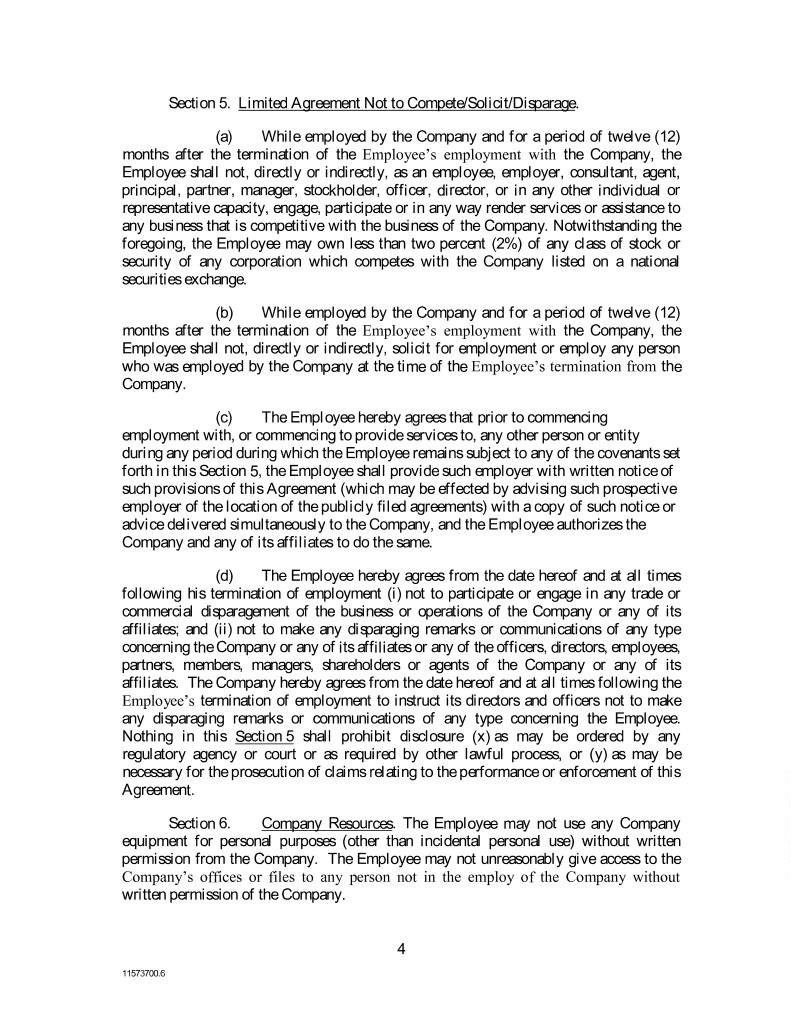
Section 5. Limited Agreement Not to Compete/Solicit/Disparage. (a) While employed by the Company and for a period of twelve (12) months after the termination of the Employee’s employment with the Company, the Employee shall not, directly or indirectly, as an employee, employer, consultant, agent, principal, partner, manager, stockholder, officer, director, or in any other individual or representative capacity, engage, participate or in any way render services or assistance to any business that is competitive with the business of the Company. Notwithstanding the foregoing, the Employee may own less than two percent (2%) of any class of stock or security of any corporation which competes with the Company listed on a national securities exchange. (b) While employed by the Company and for a period of twelve (12) months after the termination of the Employee’s employment with the Company, the Employee shall not, directly or indirectly, solicit for employment or employ any person who was employed by the Company at the time of the Employee’s termination from the Company. (c) The Employee hereby agrees that prior to commencing employment with, or commencing to provide services to, any other person or entity during any period during which the Employee remains subject to any of the covenants set forth in this Section 5, the Employee shall provide such employer with written notice of such provisions of this Agreement (which may be effected by advising such prospective employer of the location of the publicly filed agreements) with a copy of such notice or advice delivered simultaneously to the Company, and the Employee authorizes the Company and any of its affiliates to do the same. (d) The Employee hereby agrees from the date hereof and at all times following his termination of employment (i) not to participate or engage in any trade or commercial disparagement of the business or operations of the Company or any of its affiliates; and (ii) not to make any disparaging remarks or communications of any type concerning the Company or any of its affiliates or any of the officers, directors, employees, partners, members, managers, shareholders or agents of the Company or any of its affiliates. The Company hereby agrees from the date hereof and at all times following the Employee’s termination of employment to instruct its directors and officers not to make any disparaging remarks or communications of any type concerning the Employee. Nothing in this Section 5 shall prohibit disclosure (x) as may be ordered by any regulatory agency or court or as required by other lawful process, or (y) as may be necessary for the prosecution of claims relating to the performance or enforcement of this Agreement. Section 6. Company Resources. The Employee may not use any Company equipment for personal purposes (other than incidental personal use) without written permission from the Company. The Employee may not unreasonably give access to the Company’s offices or files to any person not in the employ of the Company without written permission of the Company. 4 11573700.6
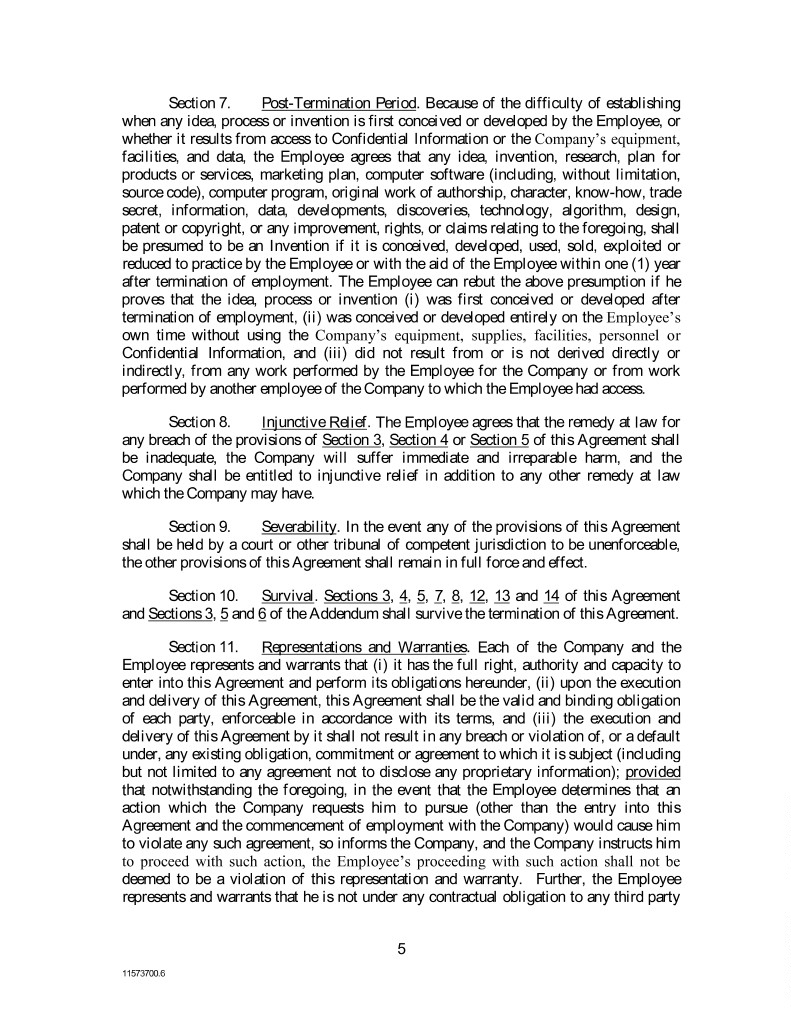
Section 7. Post-Termination Period. Because of the difficulty of establishing when any idea, process or invention is first conceived or developed by the Employee, or whether it results from access to Confidential Information or the Company’s equipment, facilities, and data, the Employee agrees that any idea, invention, research, plan for products or services, marketing plan, computer software (including, without limitation, source code), computer program, original work of authorship, character, know-how, trade secret, information, data, developments, discoveries, technology, algorithm, design, patent or copyright, or any improvement, rights, or claims relating to the foregoing, shall be presumed to be an Invention if it is conceived, developed, used, sold, exploited or reduced to practice by the Employee or with the aid of the Employee within one (1) year after termination of employment. The Employee can rebut the above presumption if he proves that the idea, process or invention (i) was first conceived or developed after termination of employment, (ii) was conceived or developed entirely on the Employee’s own time without using the Company’s equipment, supplies, facilities, personnel or Confidential Information, and (iii) did not result from or is not derived directly or indirectly, from any work performed by the Employee for the Company or from work performed by another employee of the Company to which the Employee had access. Section 8. Injunctive Relief. The Employee agrees that the remedy at law for any breach of the provisions of Section 3, Section 4 or Section 5 of this Agreement shall be inadequate, the Company will suffer immediate and irreparable harm, and the Company shall be entitled to injunctive relief in addition to any other remedy at law which the Company may have. Section 9. Severability. In the event any of the provisions of this Agreement shall be held by a court or other tribunal of competent jurisdiction to be unenforceable, the other provisions of this Agreement shall remain in full force and effect. Section 10. Survival. Sections 3, 4, 5, 7, 8, 12, 13 and 14 of this Agreement and Sections 3, 5 and 6 of the Addendum shall survive the termination of this Agreement. Section 11. Representations and Warranties. Each of the Company and the Employee represents and warrants that (i) it has the full right, authority and capacity to enter into this Agreement and perform its obligations hereunder, (ii) upon the execution and delivery of this Agreement, this Agreement shall be the valid and binding obligation of each party, enforceable in accordance with its terms, and (iii) the execution and delivery of this Agreement by it shall not result in any breach or violation of, or a default under, any existing obligation, commitment or agreement to which it is subject (including but not limited to any agreement not to disclose any proprietary information); provided that notwithstanding the foregoing, in the event that the Employee determines that an action which the Company requests him to pursue (other than the entry into this Agreement and the commencement of employment with the Company) would cause him to violate any such agreement, so informs the Company, and the Company instructs him to proceed with such action, the Employee’s proceeding with such action shall not be deemed to be a violation of this representation and warranty. Further, the Employee represents and warrants that he is not under any contractual obligation to any third party 5 11573700.6
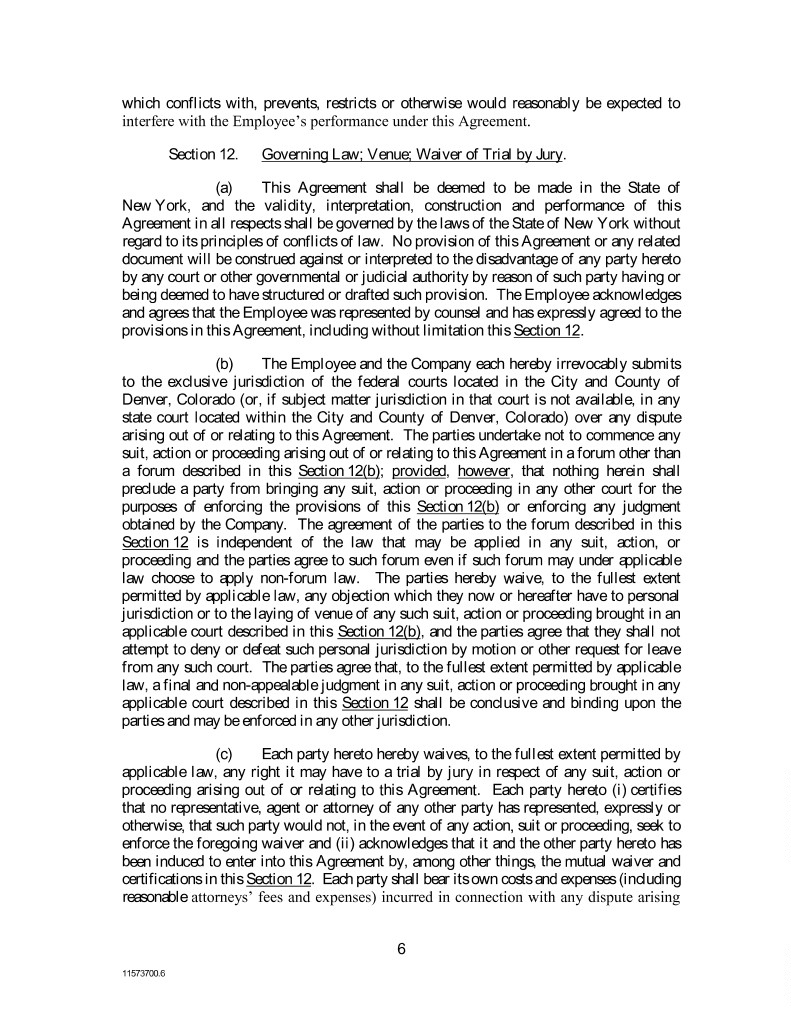
which conflicts with, prevents, restricts or otherwise would reasonably be expected to interfere with the Employee’s performance under this Agreement. Section 12. Governing Law; Venue; Waiver of Trial by Jury. (a) This Agreement shall be deemed to be made in the State of New York, and the validity, interpretation, construction and performance of this Agreement in all respects shall be governed by the laws of the State of New York without regard to its principles of conflicts of law. No provision of this Agreement or any related document will be construed against or interpreted to the disadvantage of any party hereto by any court or other governmental or judicial authority by reason of such party having or being deemed to have structured or drafted such provision. The Employee acknowledges and agrees that the Employee was represented by counsel and has expressly agreed to the provisions in this Agreement, including without limitation this Section 12. (b) The Employee and the Company each hereby irrevocably submits to the exclusive jurisdiction of the federal courts located in the City and County of Denver, Colorado (or, if subject matter jurisdiction in that court is not available, in any state court located within the City and County of Denver, Colorado) over any dispute arising out of or relating to this Agreement. The parties undertake not to commence any suit, action or proceeding arising out of or relating to this Agreement in a forum other than a forum described in this Section 12(b); provided, however, that nothing herein shall preclude a party from bringing any suit, action or proceeding in any other court for the purposes of enforcing the provisions of this Section 12(b) or enforcing any judgment obtained by the Company. The agreement of the parties to the forum described in this Section 12 is independent of the law that may be applied in any suit, action, or proceeding and the parties agree to such forum even if such forum may under applicable law choose to apply non-forum law. The parties hereby waive, to the fullest extent permitted by applicable law, any objection which they now or hereafter have to personal jurisdiction or to the laying of venue of any such suit, action or proceeding brought in an applicable court described in this Section 12(b), and the parties agree that they shall not attempt to deny or defeat such personal jurisdiction by motion or other request for leave from any such court. The parties agree that, to the fullest extent permitted by applicable law, a final and non-appealable judgment in any suit, action or proceeding brought in any applicable court described in this Section 12 shall be conclusive and binding upon the parties and may be enforced in any other jurisdiction. (c) Each party hereto hereby waives, to the fullest extent permitted by applicable law, any right it may have to a trial by jury in respect of any suit, action or proceeding arising out of or relating to this Agreement. Each party hereto (i) certifies that no representative, agent or attorney of any other party has represented, expressly or otherwise, that such party would not, in the event of any action, suit or proceeding, seek to enforce the foregoing waiver and (ii) acknowledges that it and the other party hereto has been induced to enter into this Agreement by, among other things, the mutual waiver and certifications in this Section 12. Each party shall bear its own costs and expenses (including reasonable attorneys’ fees and expenses) incurred in connection with any dispute arising 6 11573700.6
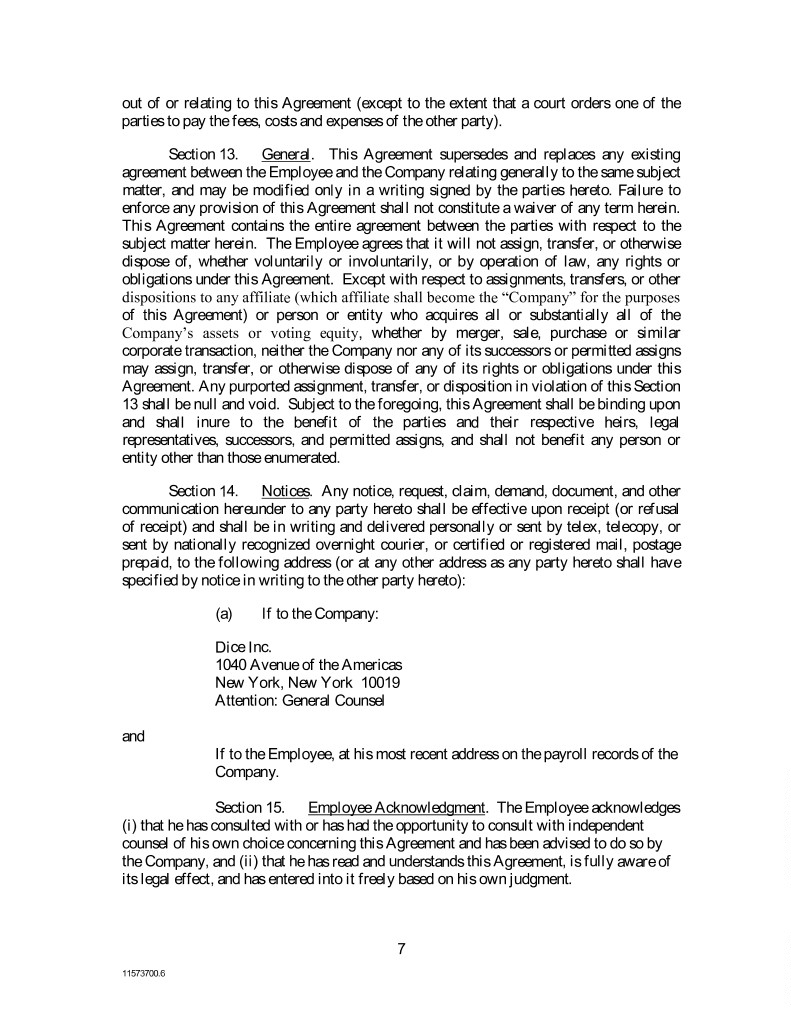
out of or relating to this Agreement (except to the extent that a court orders one of the parties to pay the fees, costs and expenses of the other party). Section 13. General. This Agreement supersedes and replaces any existing agreement between the Employee and the Company relating generally to the same subject matter, and may be modified only in a writing signed by the parties hereto. Failure to enforce any provision of this Agreement shall not constitute a waiver of any term herein. This Agreement contains the entire agreement between the parties with respect to the subject matter herein. The Employee agrees that it will not assign, transfer, or otherwise dispose of, whether voluntarily or involuntarily, or by operation of law, any rights or obligations under this Agreement. Except with respect to assignments, transfers, or other dispositions to any affiliate (which affiliate shall become the “Company” for the purposes of this Agreement) or person or entity who acquires all or substantially all of the Company’s assets or voting equity, whether by merger, sale, purchase or similar corporate transaction, neither the Company nor any of its successors or permitted assigns may assign, transfer, or otherwise dispose of any of its rights or obligations under this Agreement. Any purported assignment, transfer, or disposition in violation of this Section 13 shall be null and void. Subject to the foregoing, this Agreement shall be binding upon and shall inure to the benefit of the parties and their respective heirs, legal representatives, successors, and permitted assigns, and shall not benefit any person or entity other than those enumerated. Section 14. Notices. Any notice, request, claim, demand, document, and other communication hereunder to any party hereto shall be effective upon receipt (or refusal of receipt) and shall be in writing and delivered personally or sent by telex, telecopy, or sent by nationally recognized overnight courier, or certified or registered mail, postage prepaid, to the following address (or at any other address as any party hereto shall have specified by notice in writing to the other party hereto): (a) If to the Company: Dice Inc. 0000 Xxxxxx xx xxx Xxxxxxxx Xxx Xxxx, Xxx Xxxx 00000 Attention: General Counsel and If to the Employee, at his most recent address on the payroll records of the Company. Section 15. Employee Acknowledgment. The Employee acknowledges (i) that he has consulted with or has had the opportunity to consult with independent counsel of his own choice concerning this Agreement and has been advised to do so by the Company, and (ii) that he has read and understands this Agreement, is fully aware of its legal effect, and has entered into it freely based on his own judgment. 7 11573700.6
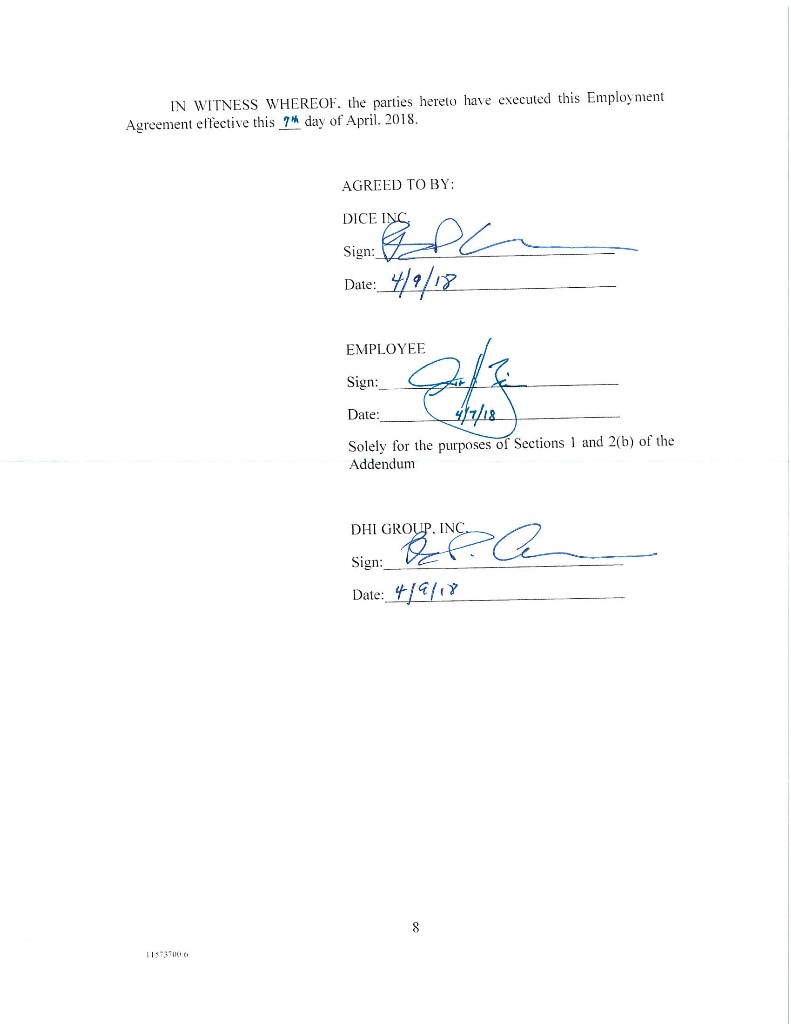
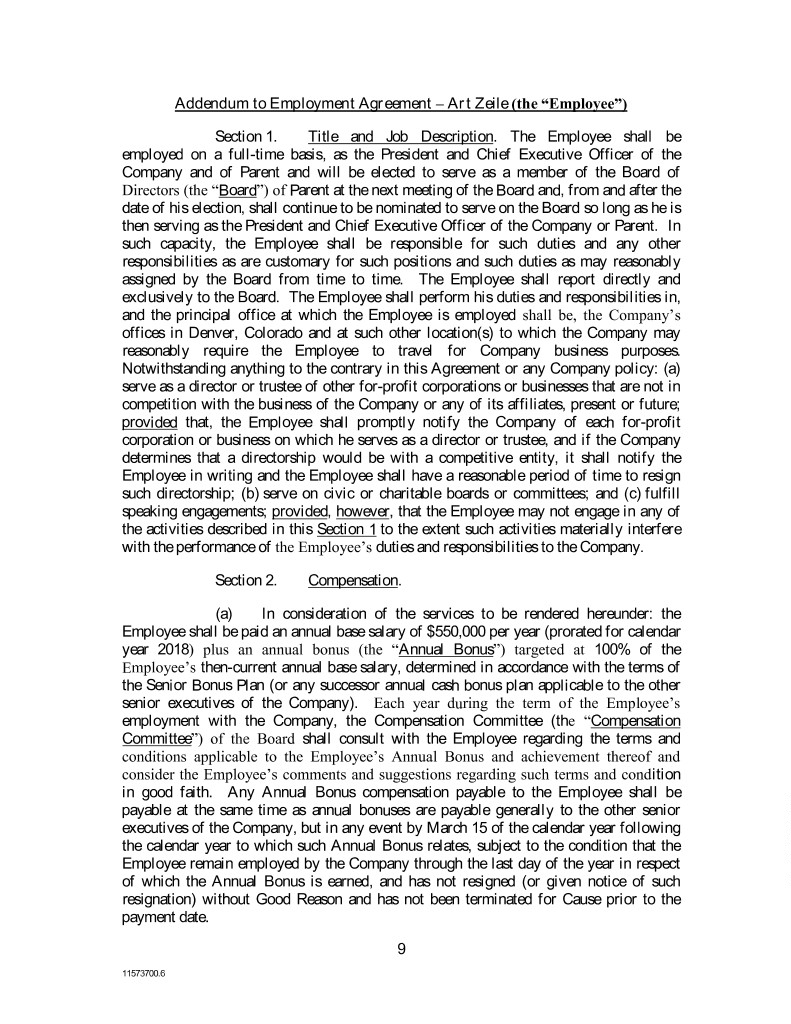
Addendum to Employment Agreement – Art Zeile (the “Employee”) Section 1. Title and Job Description. The Employee shall be employed on a full-time basis, as the President and Chief Executive Officer of the Company and of Parent and will be elected to serve as a member of the Board of Directors (the “Board”) of Parent at the next meeting of the Board and, from and after the date of his election, shall continue to be nominated to serve on the Board so long as he is then serving as the President and Chief Executive Officer of the Company or Parent. In such capacity, the Employee shall be responsible for such duties and any other responsibilities as are customary for such positions and such duties as may reasonably assigned by the Board from time to time. The Employee shall report directly and exclusively to the Board. The Employee shall perform his duties and responsibilities in, and the principal office at which the Employee is employed shall be, the Company’s offices in Denver, Colorado and at such other location(s) to which the Company may reasonably require the Employee to travel for Company business purposes. Notwithstanding anything to the contrary in this Agreement or any Company policy: (a) serve as a director or trustee of other for-profit corporations or businesses that are not in competition with the business of the Company or any of its affiliates, present or future; provided that, the Employee shall promptly notify the Company of each for-profit corporation or business on which he serves as a director or trustee, and if the Company determines that a directorship would be with a competitive entity, it shall notify the Employee in writing and the Employee shall have a reasonable period of time to resign such directorship; (b) serve on civic or charitable boards or committees; and (c) fulfill speaking engagements; provided, however, that the Employee may not engage in any of the activities described in this Section 1 to the extent such activities materially interfere with the performance of the Employee’s duties and responsibilities to the Company. Section 2. Compensation. (a) In consideration of the services to be rendered hereunder: the Employee shall be paid an annual base salary of $550,000 per year (prorated for calendar year 2018) plus an annual bonus (the “Annual Bonus”) targeted at 100% of the Employee’s then-current annual base salary, determined in accordance with the terms of the Senior Bonus Plan (or any successor annual cash bonus plan applicable to the other senior executives of the Company). Each year during the term of the Employee’s employment with the Company, the Compensation Committee (the “Compensation Committee”) of the Board shall consult with the Employee regarding the terms and conditions applicable to the Employee’s Annual Bonus and achievement thereof and consider the Employee’s comments and suggestions regarding such terms and condition in good faith. Any Annual Bonus compensation payable to the Employee shall be payable at the same time as annual bonuses are payable generally to the other senior executives of the Company, but in any event by March 15 of the calendar year following the calendar year to which such Annual Bonus relates, subject to the condition that the Employee remain employed by the Company through the last day of the year in respect of which the Annual Bonus is earned, and has not resigned (or given notice of such resignation) without Good Reason and has not been terminated for Cause prior to the payment date. 9 11573700.6
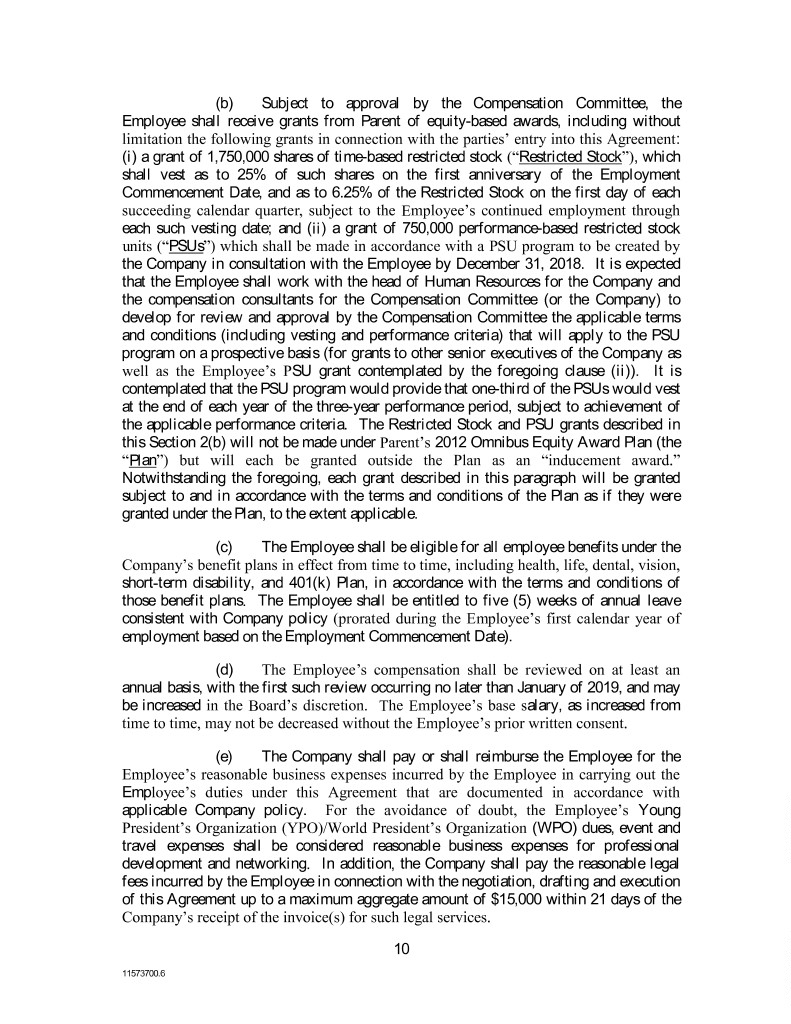
(b) Subject to approval by the Compensation Committee, the Employee shall receive grants from Parent of equity-based awards, including without limitation the following grants in connection with the parties’ entry into this Agreement: (i) a grant of 1,750,000 shares of time-based restricted stock (“Restricted Stock”), which shall vest as to 25% of such shares on the first anniversary of the Employment Commencement Date, and as to 6.25% of the Restricted Stock on the first day of each succeeding calendar quarter, subject to the Employee’s continued employment through each such vesting date; and (ii) a grant of 750,000 performance-based restricted stock units (“PSUs”) which shall be made in accordance with a PSU program to be created by the Company in consultation with the Employee by December 31, 2018. It is expected that the Employee shall work with the head of Human Resources for the Company and the compensation consultants for the Compensation Committee (or the Company) to develop for review and approval by the Compensation Committee the applicable terms and conditions (including vesting and performance criteria) that will apply to the PSU program on a prospective basis (for grants to other senior executives of the Company as well as the Employee’s PSU grant contemplated by the foregoing clause (ii)). It is contemplated that the PSU program would provide that one-third of the PSUs would vest at the end of each year of the three-year performance period, subject to achievement of the applicable performance criteria. The Restricted Stock and PSU grants described in this Section 2(b) will not be made under Parent’s 2012 Omnibus Equity Award Plan (the “Plan”) but will each be granted outside the Plan as an “inducement award.” Notwithstanding the foregoing, each grant described in this paragraph will be granted subject to and in accordance with the terms and conditions of the Plan as if they were granted under the Plan, to the extent applicable. (c) The Employee shall be eligible for all employee benefits under the Company’s benefit plans in effect from time to time, including health, life, dental, vision, short-term disability, and 401(k) Plan, in accordance with the terms and conditions of those benefit plans. The Employee shall be entitled to five (5) weeks of annual leave consistent with Company policy (prorated during the Employee’s first calendar year of employment based on the Employment Commencement Date). (d) The Employee’s compensation shall be reviewed on at least an annual basis, with the first such review occurring no later than January of 2019, and may be increased in the Board’s discretion. The Employee’s base salary, as increased from time to time, may not be decreased without the Employee’s prior written consent. (e) The Company shall pay or shall reimburse the Employee for the Employee’s reasonable business expenses incurred by the Employee in carrying out the Employee’s duties under this Agreement that are documented in accordance with applicable Company policy. For the avoidance of doubt, the Employee’s Young President’s Organization (YPO)/World President’s Organization (WPO) dues, event and travel expenses shall be considered reasonable business expenses for professional development and networking. In addition, the Company shall pay the reasonable legal fees incurred by the Employee in connection with the negotiation, drafting and execution of this Agreement up to a maximum aggregate amount of $15,000 within 21 days of the Company’s receipt of the invoice(s) for such legal services. 10 11573700.6
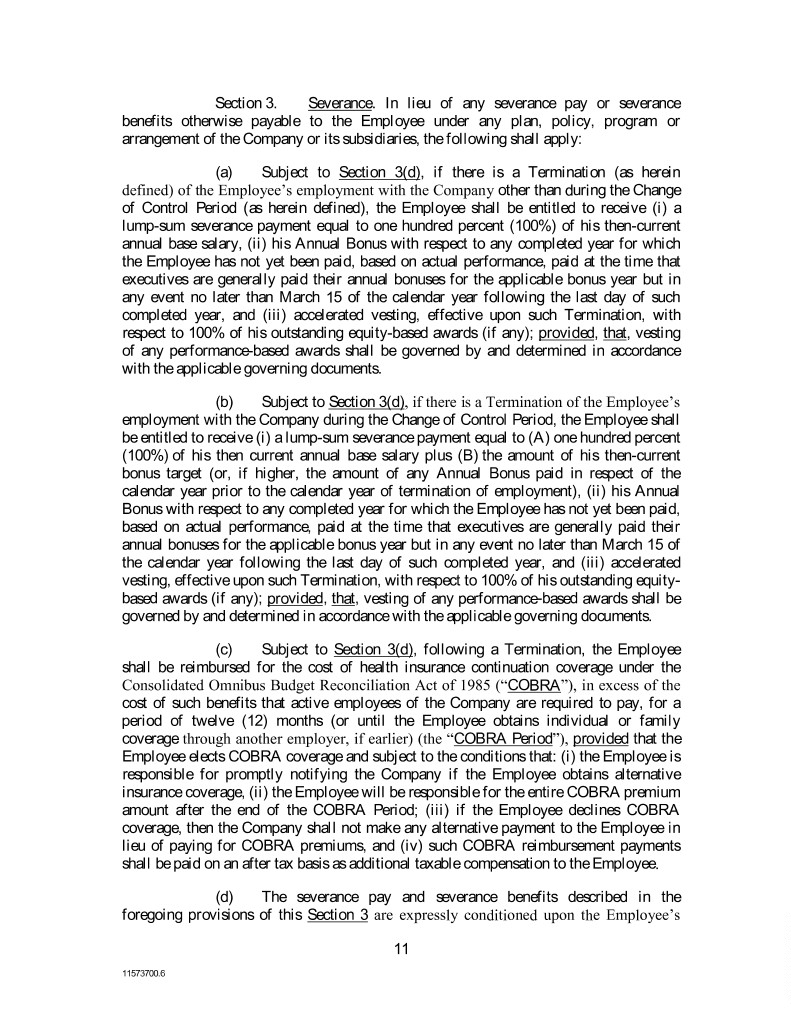
Section 3. Severance. In lieu of any severance pay or severance benefits otherwise payable to the Employee under any plan, policy, program or arrangement of the Company or its subsidiaries, the following shall apply: (a) Subject to Section 3(d), if there is a Termination (as herein defined) of the Employee’s employment with the Company other than during the Change of Control Period (as herein defined), the Employee shall be entitled to receive (i) a lump-sum severance payment equal to one hundred percent (100%) of his then-current annual base salary, (ii) his Annual Bonus with respect to any completed year for which the Employee has not yet been paid, based on actual performance, paid at the time that executives are generally paid their annual bonuses for the applicable bonus year but in any event no later than March 15 of the calendar year following the last day of such completed year, and (iii) accelerated vesting, effective upon such Termination, with respect to 100% of his outstanding equity-based awards (if any); provided, that, vesting of any performance-based awards shall be governed by and determined in accordance with the applicable governing documents. (b) Subject to Section 3(d), if there is a Termination of the Employee’s employment with the Company during the Change of Control Period, the Employee shall be entitled to receive (i) a lump-sum severance payment equal to (A) one hundred percent (100%) of his then current annual base salary plus (B) the amount of his then-current bonus target (or, if higher, the amount of any Annual Bonus paid in respect of the calendar year prior to the calendar year of termination of employment), (ii) his Annual Bonus with respect to any completed year for which the Employee has not yet been paid, based on actual performance, paid at the time that executives are generally paid their annual bonuses for the applicable bonus year but in any event no later than March 15 of the calendar year following the last day of such completed year, and (iii) accelerated vesting, effective upon such Termination, with respect to 100% of his outstanding equity- based awards (if any); provided, that, vesting of any performance-based awards shall be governed by and determined in accordance with the applicable governing documents. (c) Subject to Section 3(d), following a Termination, the Employee shall be reimbursed for the cost of health insurance continuation coverage under the Consolidated Omnibus Budget Reconciliation Act of 1985 (“COBRA”), in excess of the cost of such benefits that active employees of the Company are required to pay, for a period of twelve (12) months (or until the Employee obtains individual or family coverage through another employer, if earlier) (the “COBRA Period”), provided that the Employee elects COBRA coverage and subject to the conditions that: (i) the Employee is responsible for promptly notifying the Company if the Employee obtains alternative insurance coverage, (ii) the Employee will be responsible for the entire COBRA premium amount after the end of the COBRA Period; (iii) if the Employee declines COBRA coverage, then the Company shall not make any alternative payment to the Employee in lieu of paying for COBRA premiums, and (iv) such COBRA reimbursement payments shall be paid on an after tax basis as additional taxable compensation to the Employee. (d) The severance pay and severance benefits described in the foregoing provisions of this Section 3 are expressly conditioned upon the Employee’s 11 11573700.6
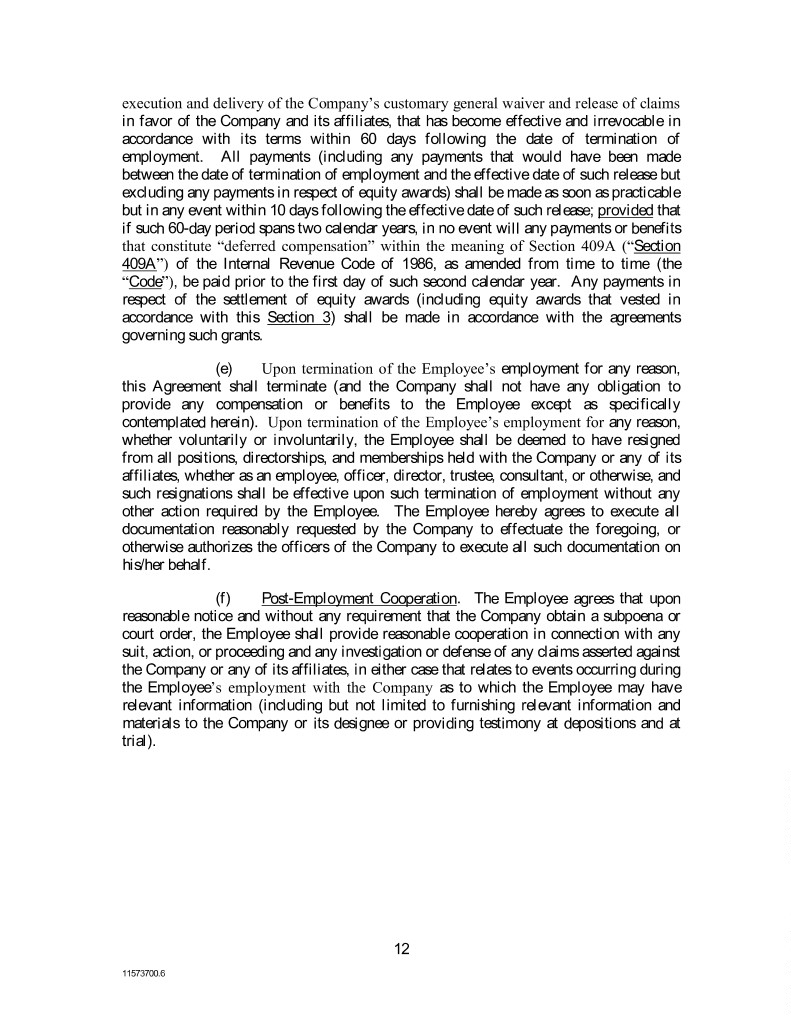
execution and delivery of the Company’s customary general waiver and release of claims in favor of the Company and its affiliates, that has become effective and irrevocable in accordance with its terms within 60 days following the date of termination of employment. All payments (including any payments that would have been made between the date of termination of employment and the effective date of such release but excluding any payments in respect of equity awards) shall be made as soon as practicable but in any event within 10 days following the effective date of such release; provided that if such 60-day period spans two calendar years, in no event will any payments or benefits that constitute “deferred compensation” within the meaning of Section 409A (“Section 409A”) of the Internal Revenue Code of 1986, as amended from time to time (the “Code”), be paid prior to the first day of such second calendar year. Any payments in respect of the settlement of equity awards (including equity awards that vested in accordance with this Section 3) shall be made in accordance with the agreements governing such grants. (e) Upon termination of the Employee’s employment for any reason, this Agreement shall terminate (and the Company shall not have any obligation to provide any compensation or benefits to the Employee except as specifically contemplated herein). Upon termination of the Employee’s employment for any reason, whether voluntarily or involuntarily, the Employee shall be deemed to have resigned from all positions, directorships, and memberships held with the Company or any of its affiliates, whether as an employee, officer, director, trustee, consultant, or otherwise, and such resignations shall be effective upon such termination of employment without any other action required by the Employee. The Employee hereby agrees to execute all documentation reasonably requested by the Company to effectuate the foregoing, or otherwise authorizes the officers of the Company to execute all such documentation on his/her behalf. (f) Post-Employment Cooperation. The Employee agrees that upon reasonable notice and without any requirement that the Company obtain a subpoena or court order, the Employee shall provide reasonable cooperation in connection with any suit, action, or proceeding and any investigation or defense of any claims asserted against the Company or any of its affiliates, in either case that relates to events occurring during the Employee’s employment with the Company as to which the Employee may have relevant information (including but not limited to furnishing relevant information and materials to the Company or its designee or providing testimony at depositions and at trial). 12 11573700.6
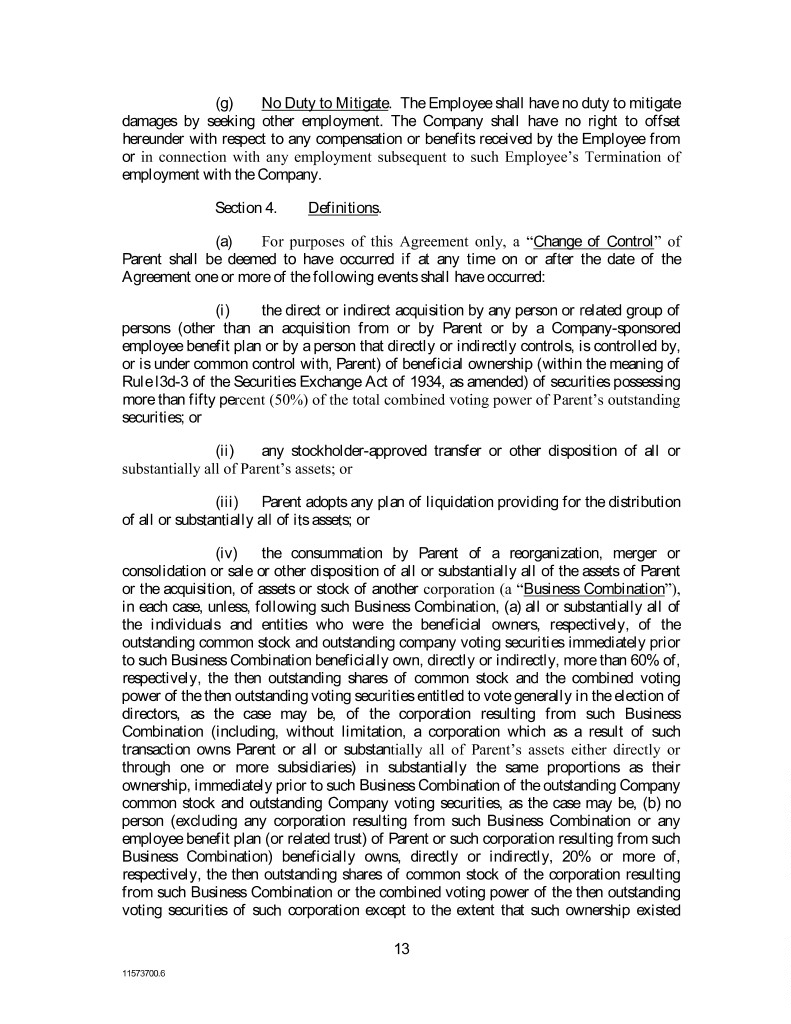
(g) No Duty to Mitigate. The Employee shall have no duty to mitigate damages by seeking other employment. The Company shall have no right to offset hereunder with respect to any compensation or benefits received by the Employee from or in connection with any employment subsequent to such Employee’s Termination of employment with the Company. Section 4. Definitions. (a) For purposes of this Agreement only, a “Change of Control” of Parent shall be deemed to have occurred if at any time on or after the date of the Agreement one or more of the following events shall have occurred: (i) the direct or indirect acquisition by any person or related group of persons (other than an acquisition from or by Parent or by a Company-sponsored employee benefit plan or by a person that directly or indirectly controls, is controlled by, or is under common control with, Parent) of beneficial ownership (within the meaning of Rule l3d-3 of the Securities Exchange Act of 1934, as amended) of securities possessing more than fifty percent (50%) of the total combined voting power of Parent’s outstanding securities; or (ii) any stockholder-approved transfer or other disposition of all or substantially all of Parent’s assets; or (iii) Parent adopts any plan of liquidation providing for the distribution of all or substantially all of its assets; or (iv) the consummation by Parent of a reorganization, merger or consolidation or sale or other disposition of all or substantially all of the assets of Parent or the acquisition, of assets or stock of another corporation (a “Business Combination”), in each case, unless, following such Business Combination, (a) all or substantially all of the individuals and entities who were the beneficial owners, respectively, of the outstanding common stock and outstanding company voting securities immediately prior to such Business Combination beneficially own, directly or indirectly, more than 60% of, respectively, the then outstanding shares of common stock and the combined voting power of the then outstanding voting securities entitled to vote generally in the election of directors, as the case may be, of the corporation resulting from such Business Combination (including, without limitation, a corporation which as a result of such transaction owns Parent or all or substantially all of Parent’s assets either directly or through one or more subsidiaries) in substantially the same proportions as their ownership, immediately prior to such Business Combination of the outstanding Company common stock and outstanding Company voting securities, as the case may be, (b) no person (excluding any corporation resulting from such Business Combination or any employee benefit plan (or related trust) of Parent or such corporation resulting from such Business Combination) beneficially owns, directly or indirectly, 20% or more of, respectively, the then outstanding shares of common stock of the corporation resulting from such Business Combination or the combined voting power of the then outstanding voting securities of such corporation except to the extent that such ownership existed 13 11573700.6
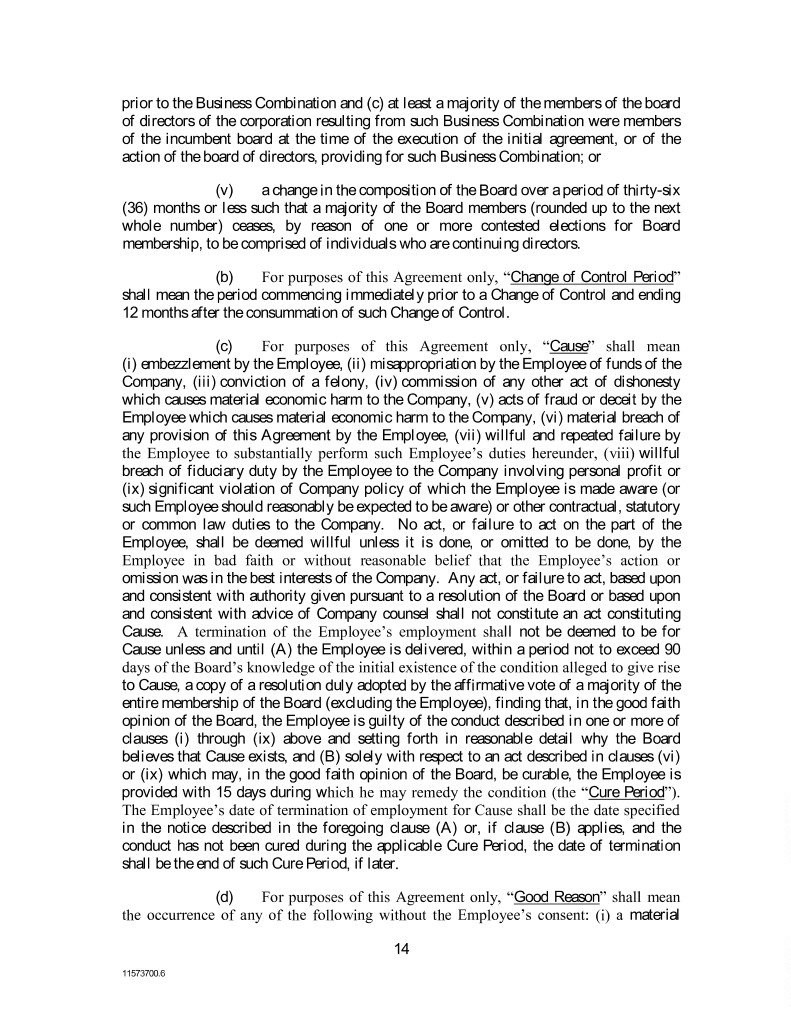
prior to the Business Combination and (c) at least a majority of the members of the board of directors of the corporation resulting from such Business Combination were members of the incumbent board at the time of the execution of the initial agreement, or of the action of the board of directors, providing for such Business Combination; or (v) a change in the composition of the Board over a period of thirty-six (36) months or less such that a majority of the Board members (rounded up to the next whole number) ceases, by reason of one or more contested elections for Board membership, to be comprised of individuals who are continuing directors. (b) For purposes of this Agreement only, “Change of Control Period” shall mean the period commencing immediately prior to a Change of Control and ending 12 months after the consummation of such Change of Control. (c) For purposes of this Agreement only, “Cause” shall mean (i) embezzlement by the Employee, (ii) misappropriation by the Employee of funds of the Company, (iii) conviction of a felony, (iv) commission of any other act of dishonesty which causes material economic harm to the Company, (v) acts of fraud or deceit by the Employee which causes material economic harm to the Company, (vi) material breach of any provision of this Agreement by the Employee, (vii) willful and repeated failure by the Employee to substantially perform such Employee’s duties hereunder, (viii) willful breach of fiduciary duty by the Employee to the Company involving personal profit or (ix) significant violation of Company policy of which the Employee is made aware (or such Employee should reasonably be expected to be aware) or other contractual, statutory or common law duties to the Company. No act, or failure to act on the part of the Employee, shall be deemed willful unless it is done, or omitted to be done, by the Employee in bad faith or without reasonable belief that the Employee’s action or omission was in the best interests of the Company. Any act, or failure to act, based upon and consistent with authority given pursuant to a resolution of the Board or based upon and consistent with advice of Company counsel shall not constitute an act constituting Cause. A termination of the Employee’s employment shall not be deemed to be for Cause unless and until (A) the Employee is delivered, within a period not to exceed 90 days of the Board’s knowledge of the initial existence of the condition alleged to give rise to Cause, a copy of a resolution duly adopted by the affirmative vote of a majority of the entire membership of the Board (excluding the Employee), finding that, in the good faith opinion of the Board, the Employee is guilty of the conduct described in one or more of clauses (i) through (ix) above and setting forth in reasonable detail why the Board believes that Cause exists, and (B) solely with respect to an act described in clauses (vi) or (ix) which may, in the good faith opinion of the Board, be curable, the Employee is provided with 15 days during which he may remedy the condition (the “Cure Period”). The Employee’s date of termination of employment for Cause shall be the date specified in the notice described in the foregoing clause (A) or, if clause (B) applies, and the conduct has not been cured during the applicable Cure Period, the date of termination shall be the end of such Cure Period, if later. (d) For purposes of this Agreement only, “Good Reason” shall mean the occurrence of any of the following without the Employee’s consent: (i) a material 14 11573700.6
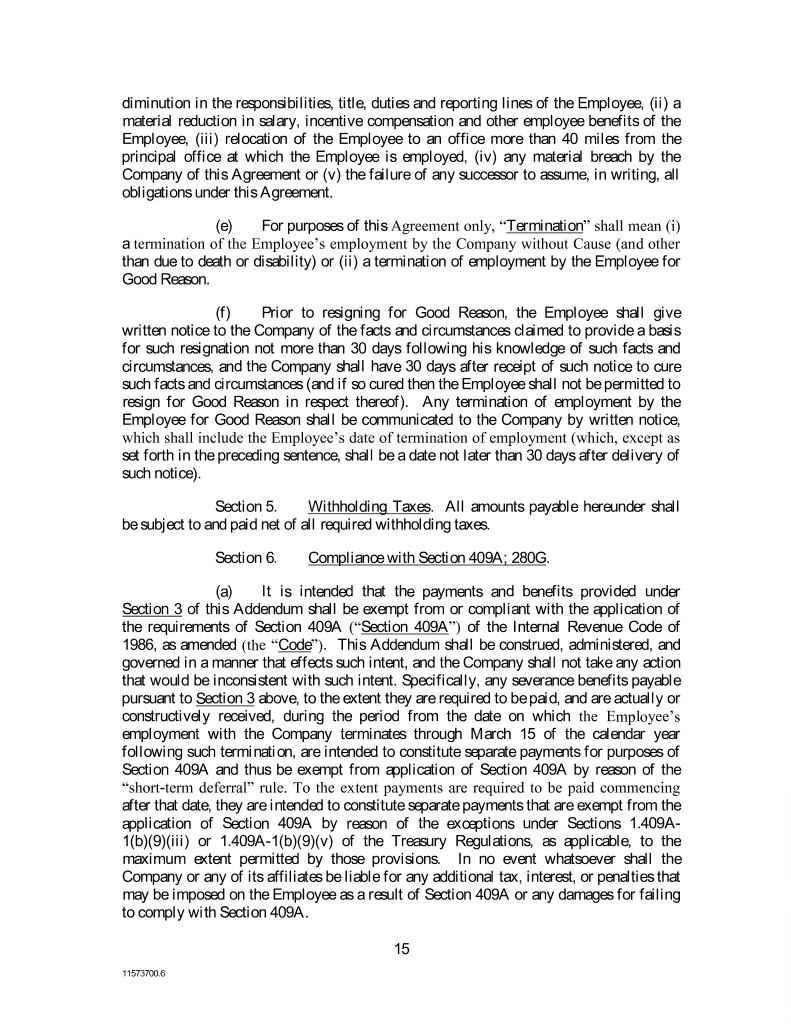
diminution in the responsibilities, title, duties and reporting lines of the Employee, (ii) a material reduction in salary, incentive compensation and other employee benefits of the Employee, (iii) relocation of the Employee to an office more than 40 miles from the principal office at which the Employee is employed, (iv) any material breach by the Company of this Agreement or (v) the failure of any successor to assume, in writing, all obligations under this Agreement. (e) For purposes of this Agreement only, “Termination” shall mean (i) a termination of the Employee’s employment by the Company without Cause (and other than due to death or disability) or (ii) a termination of employment by the Employee for Good Reason. (f) Prior to resigning for Good Reason, the Employee shall give written notice to the Company of the facts and circumstances claimed to provide a basis for such resignation not more than 30 days following his knowledge of such facts and circumstances, and the Company shall have 30 days after receipt of such notice to cure such facts and circumstances (and if so cured then the Employee shall not be permitted to resign for Good Reason in respect thereof). Any termination of employment by the Employee for Good Reason shall be communicated to the Company by written notice, which shall include the Employee’s date of termination of employment (which, except as set forth in the preceding sentence, shall be a date not later than 30 days after delivery of such notice). Section 5. Withholding Taxes. All amounts payable hereunder shall be subject to and paid net of all required withholding taxes. Section 6. Compliance with Section 409A; 280G. (a) It is intended that the payments and benefits provided under Section 3 of this Addendum shall be exempt from or compliant with the application of the requirements of Section 409A (“Section 409A”) of the Internal Revenue Code of 1986, as amended (the “Code”). This Addendum shall be construed, administered, and governed in a manner that effects such intent, and the Company shall not take any action that would be inconsistent with such intent. Specifically, any severance benefits payable pursuant to Section 3 above, to the extent they are required to be paid, and are actually or constructively received, during the period from the date on which the Employee’s employment with the Company terminates through March 15 of the calendar year following such termination, are intended to constitute separate payments for purposes of Section 409A and thus be exempt from application of Section 409A by reason of the “short-term deferral” rule. To the extent payments are required to be paid commencing after that date, they are intended to constitute separate payments that are exempt from the application of Section 409A by reason of the exceptions under Sections 1.409A- 1(b)(9)(iii) or 1.409A-1(b)(9)(v) of the Treasury Regulations, as applicable, to the maximum extent permitted by those provisions. In no event whatsoever shall the Company or any of its affiliates be liable for any additional tax, interest, or penalties that may be imposed on the Employee as a result of Section 409A or any damages for failing to comply with Section 409A. 15 11573700.6
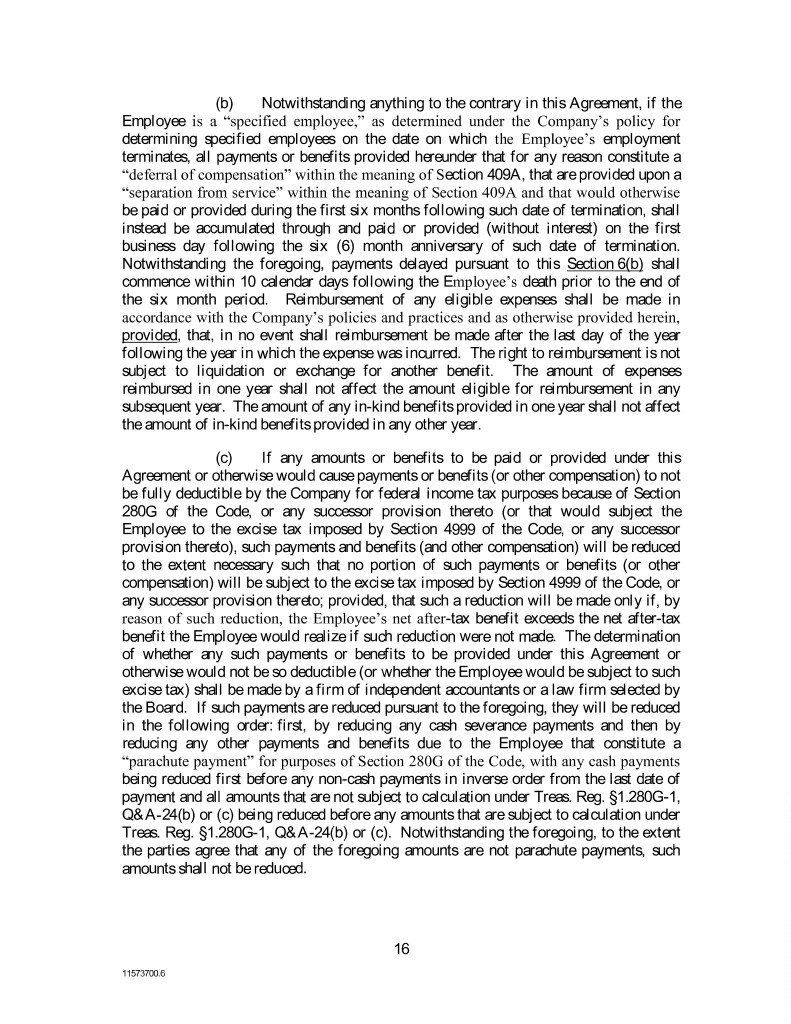
(b) Notwithstanding anything to the contrary in this Agreement, if the Employee is a “specified employee,” as determined under the Company’s policy for determining specified employees on the date on which the Employee’s employment terminates, all payments or benefits provided hereunder that for any reason constitute a “deferral of compensation” within the meaning of Section 409A, that are provided upon a “separation from service” within the meaning of Section 409A and that would otherwise be paid or provided during the first six months following such date of termination, shall instead be accumulated through and paid or provided (without interest) on the first business day following the six (6) month anniversary of such date of termination. Notwithstanding the foregoing, payments delayed pursuant to this Section 6(b) shall commence within 10 calendar days following the Employee’s death prior to the end of the six month period. Reimbursement of any eligible expenses shall be made in accordance with the Company’s policies and practices and as otherwise provided herein, provided, that, in no event shall reimbursement be made after the last day of the year following the year in which the expense was incurred. The right to reimbursement is not subject to liquidation or exchange for another benefit. The amount of expenses reimbursed in one year shall not affect the amount eligible for reimbursement in any subsequent year. The amount of any in-kind benefits provided in one year shall not affect the amount of in-kind benefits provided in any other year. (c) If any amounts or benefits to be paid or provided under this Agreement or otherwise would cause payments or benefits (or other compensation) to not be fully deductible by the Company for federal income tax purposes because of Section 280G of the Code, or any successor provision thereto (or that would subject the Employee to the excise tax imposed by Section 4999 of the Code, or any successor provision thereto), such payments and benefits (and other compensation) will be reduced to the extent necessary such that no portion of such payments or benefits (or other compensation) will be subject to the excise tax imposed by Section 4999 of the Code, or any successor provision thereto; provided, that such a reduction will be made only if, by reason of such reduction, the Employee’s net after-tax benefit exceeds the net after-tax benefit the Employee would realize if such reduction were not made. The determination of whether any such payments or benefits to be provided under this Agreement or otherwise would not be so deductible (or whether the Employee would be subject to such excise tax) shall be made by a firm of independent accountants or a law firm selected by the Board. If such payments are reduced pursuant to the foregoing, they will be reduced in the following order: first, by reducing any cash severance payments and then by reducing any other payments and benefits due to the Employee that constitute a “parachute payment” for purposes of Section 280G of the Code, with any cash payments being reduced first before any non-cash payments in inverse order from the last date of payment and all amounts that are not subject to calculation under Treas. Reg. §1.280G-1, Q&A-24(b) or (c) being reduced before any amounts that are subject to calculation under Treas. Reg. §1.280G-1, Q&A-24(b) or (c). Notwithstanding the foregoing, to the extent the parties agree that any of the foregoing amounts are not parachute payments, such amounts shall not be reduced. 16 11573700.6

